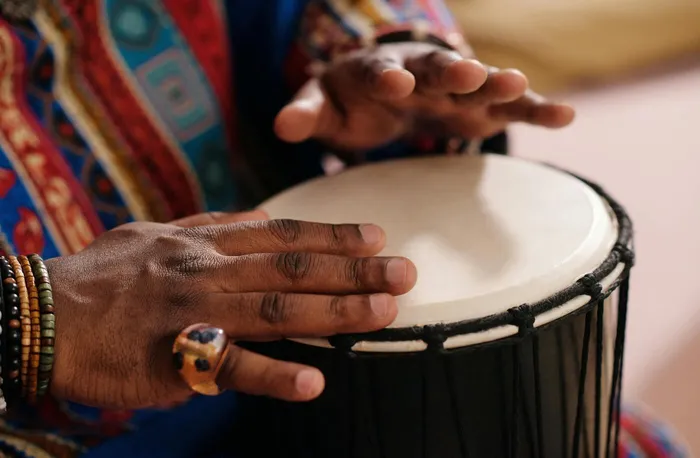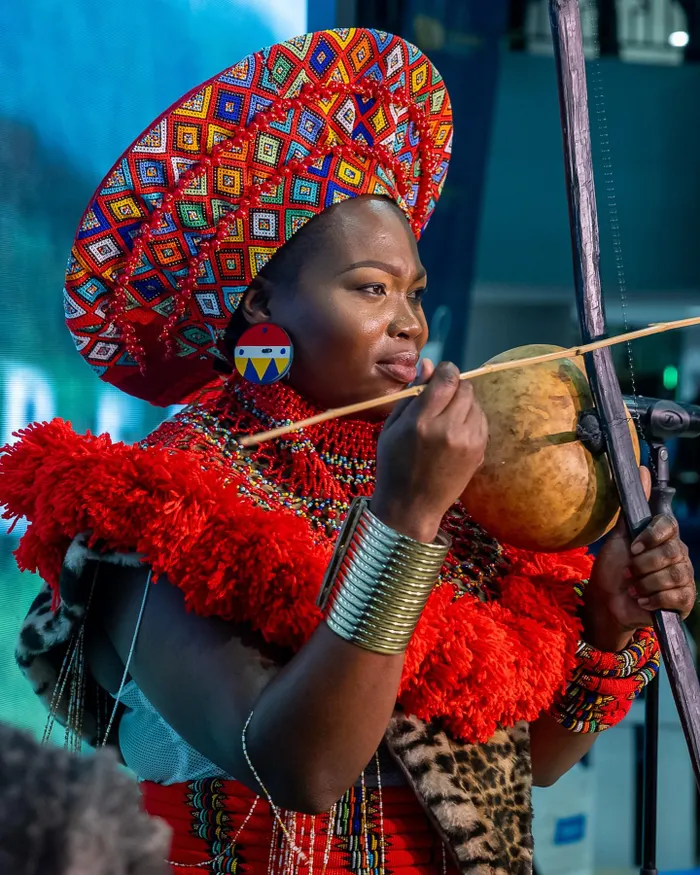The sound of heritage: how South Africa’s oldest instruments shape music today

Thandeka Mfinyongo specialises in preserving and performing Xhosa instruments, including the uhadi and umrhubhe.
Image: Facebook/Thandeka Mfinyongo
Indigenous musical instruments have long been central to cultural expression in South Africa.
They carry history, identity and social meaning.
Many of these instruments were developed within specific communities, reflecting the values and traditions of the people who created them.
Once played mainly in rural settings, today they appear in concerts, classrooms and recording studios, showing both continuity and adaptation.
South African indigenous instruments often have roots in daily life.
Many were crafted from natural materials found in the environment, such as wood, reeds, gourds, animal skin and bone. Handmade instruments carried both the creativity of their makers and the resources of the land.
As a Xhosa from the rural area of eMatyeba in Tsolo, Eastern Cape, one of the oldest and most well-known instruments I can think of is the uhadi bow, a musical bow primarily played within our culture.
It is made from a flexible stick strung with a single string and attached to a resonating gourd. The player strikes or plucks the string while using the mouth as a resonator. Its simple design contrasts with the wide range of sounds it produces.
Another instrument is the umrhubhe, a mouth-resonated bow also associated with the Xhosa.
Among the Zulu, the umakhweyana is a similar bow that uses a calabash as a resonator.
Further north, the mbira, or thumb piano, originated in Zimbabwe but has been part of cultural exchange in southern Africa for centuries. It features metal keys attached to a wooden board, often placed inside a resonating gourd or box.
Percussion instruments were made from hollowed logs or clay pots covered with animal skin.
Rattles and shakers were made from seeds, shells or gourds filled with pebbles. Wind instruments, such as flutes, were carved from reeds or bones, while horns were cut from antelope or cow horns and used to signal ceremonies or gatherings.
In traditional communities, these instruments were more than tools for entertainment. They were central to rituals, ceremonies and social life.

Indigenous instruments remain part of South African cultural life, though their role has changed.
Image: Pexels/Askar Abayev
Music marked weddings, initiation rites, harvest celebrations and healing practices. Instruments often carried symbolic meaning linked to ancestors and spirituality.
The sound of the uhadi bow, for instance, accompanied storytelling and oral traditions, carrying moral lessons, historical accounts and praise poetry. Drums called communities together, communicated messages over distances and established rhythm during collective dances.
Instruments also defined identity. The tuning of a bow or the playing of a drum signalled regional styles and cultural belonging. Young players learned from elders, ensuring continuity across generations. The making of instruments was itself a cultural act, often passed down within families.
Today, indigenous instruments remain part of South African cultural life, though their role has changed. Some are still played in rural communities for rituals and local gatherings.
Others have entered schools and universities as part of music education. Musicians and educators teach learners how to build and play these instruments, linking cultural heritage to modern learning.
In contemporary music, artists increasingly incorporate indigenous instruments to create unique sounds. Bows and mbiras have been recorded in jazz, gospel and fusion projects. Drums and rattles continue to feature in traditional dance groups performing locally and internationally.
Many South African musicians actively preserve and revitalise indigenous instruments, blending them with modern sounds to celebrate cultural heritage.
Take Zawadi YaMungu, a singer and composer who learned to play the umakhweyana and ugubhu string bows from her mother and grandmother. Her music intertwines these instruments with her vocal style, connecting listeners to their roots.

Zawadi YaMungu is a singer and composer who learned to play the umakhweyana and ugubhu string bows from her mother and grandmother.
Image: Facebook/Zawadi YaMungu
Thandeka Mfinyongo specialises in preserving and performing Xhosa instruments, including the uhadi and umrhubhe, and has performed at notable venues.
Yogin Sullaphen, part of the live looping duo uKhoiKhoi, blends indigenous and electronic music to honour ancestors and address societal issues.
Other cultures also have unique instruments. Among the Basotho, there is the Setolotolo and the Moropa (traditional drum). The Venda people play the Tshikona flute. Many other cultures share similar instruments, each with its own history and style.
Technology has expanded the reach of indigenous instruments. Recording equipment and digital platforms allow these sounds to reach global audiences.
Young artists sample and remix traditional sounds, connecting them with hip hop, electronic, and house music. This blending shows that indigenous instruments are not relics of the past but living resources for creativity.